Practical Business Applications of Relational Analytics
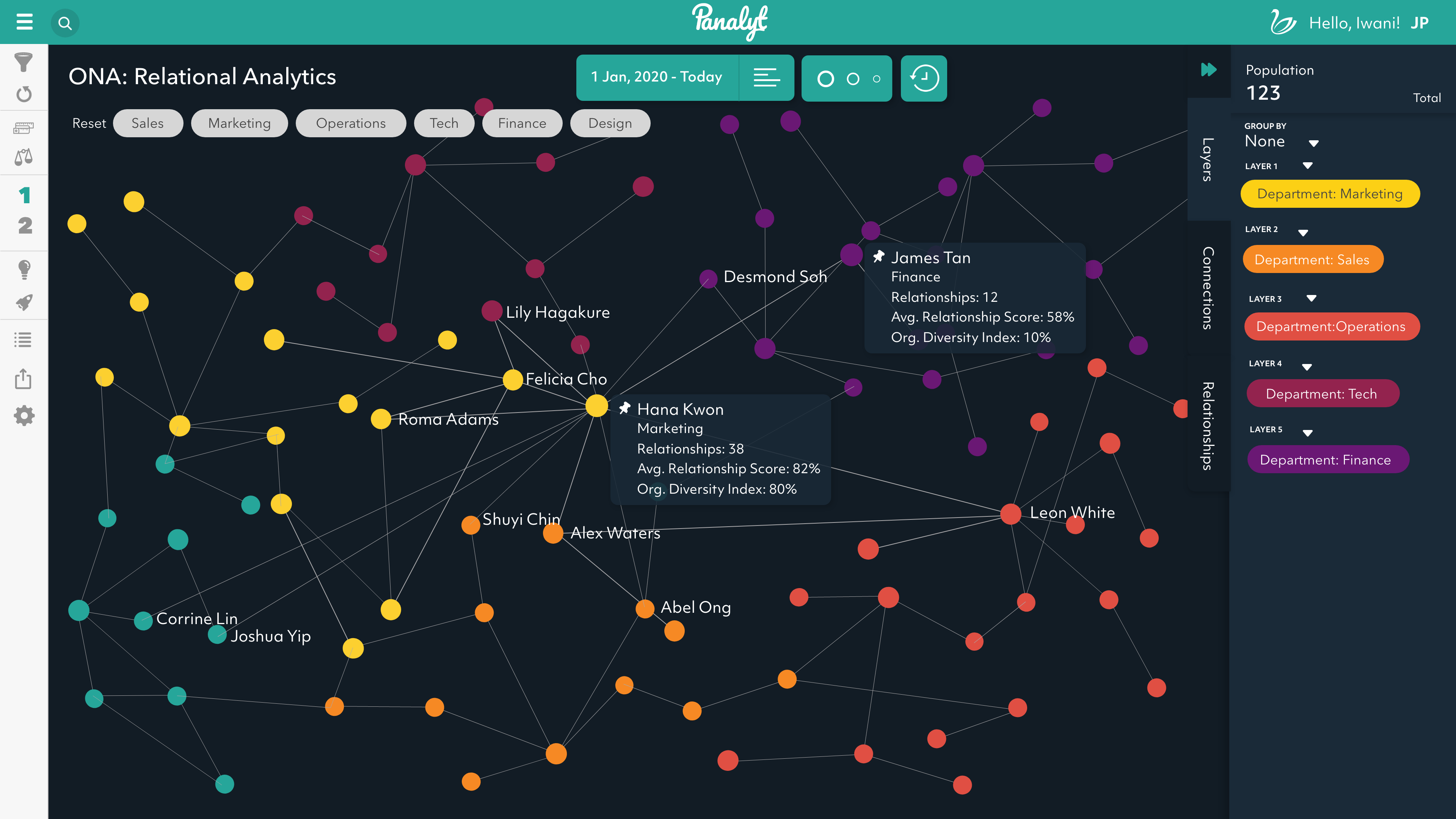
This article is a recap of the joint webinar by Panalyt and PeopleOPTI, “Practical Business Applications of Organizational Network Analysis / Relational Analytics” in which Panalyt CEO Daniel West and PeopleOPTI CEO Federico Barcos von der Heide discussed how you can use Organizational Network Analysis (ONA) to extract and leverage behavioral insights from internal and external employee communication and collaboration metadata to drive an improved employee and business outcomes, while also touching on a few extremely relevant topics such as attrition/disengagement risk, new hire virtual onboarding and integration, employee isolation, Return To Office initiatives, hybrid working silos/ cliques, and sales effectiveness.
In this article, we focus on four high-value, practical use cases where Organizational Network Analysis can enable you to identify points of intervention to drive improved employee and business outcomes:
- Attrition/Disengagement – Relational Analytics can help you quickly discover pockets of high attrition risk or disengagement risk in the organization, down to individual employee level.
- Effective Remote/Hybrid Onboarding – Relational Analytics provides a means to understand the effectiveness of employee onboarding processes, especially in remote/ hybrid work environments where it’s difficult to observe how new hires are connecting to the culture.
- Organizational Agility & Collaboration – Relational Analytics empowers you to immediately identify organizational silos, along with which individuals you should be leveraging in your change plans to bridge the gap between different teams and units.
- Sales Effectiveness – Relational Analytics provides a highly effective means of understanding how your sales teams are building and maintaining relationships with key stakeholders and decision makers at prospect / client organizations.
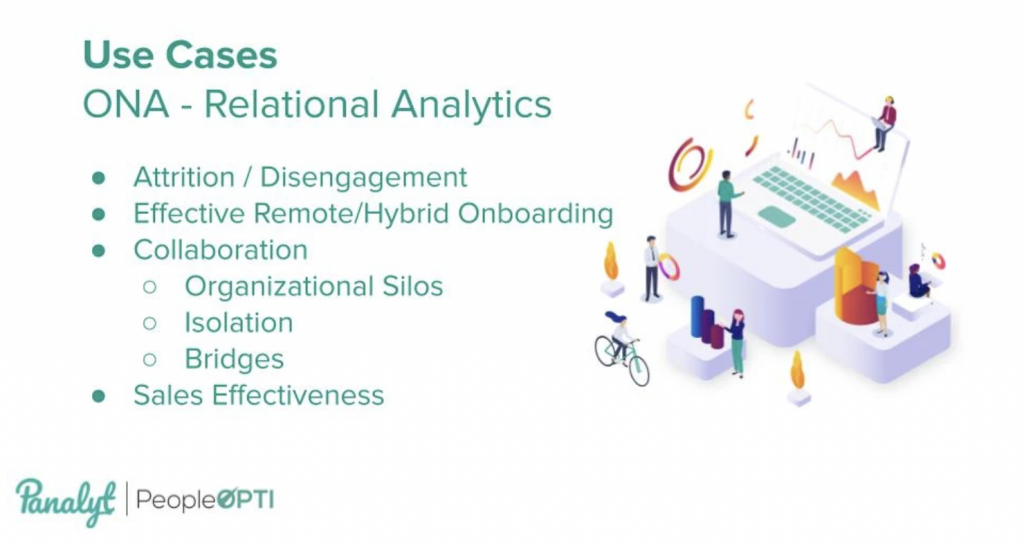
We’ll soon cover these use cases in-depth, but first a quick primer on Relational Analytics.
Introduction to Organizational Network Analysis & Relational Analytics
Organizational Network Analysis is a highly structured method of visualizing and analyzing how an organization communicates and collaborates, allowing you to understand the information and decision flow within an organization.
Business leaders and HR / Change Management practitioners have historically found it difficult to objectively measure how effectively employees are communicating within a firm, or with external stakeholders. Though organizations spend huge sums of money on “agile transformations”, “breaking silos”, “becoming more responsive” etc., we tend to rely on subjective surveys to understand the impact of these initiatives.
ONA provides a practical and extremely efficient way to understand how different stakeholders – individuals and teams – in an organization communicate with each other, going beyond the traditional organization chart to understand how an organization actually communicates and collaborates to get work done.
Relational Analytics takes ONA one step further by measuring the strength of relationships ( as compared to just the number of emails) between individuals by analyzing various communication efficiency metrics such as volume and frequency of messages, average response time, non-response %, etc.
In our experience, we’ve found that Relational Analytics can help even small organizations gain a tremendous amount of value from understanding how people are integrating into a company and their relationships. There’s usually a tipping point for organizations beyond 70 people where suddenly not everyone knows each other and it’s difficult for the C-Suite / HR leadership to have their finger on the pulse of every relationship in the same way they did before.
From optimizing the onboarding experience for new hires (or lateral / upward moves), to identifying silos and cliques within organizations, to understanding which employees / teams are at risk of disengagement and attrition, uncovering and understanding the hidden social network that drives an organization can allow you to manage your people more effectively.
Strategic EX Design with People Analytics: https://panalyt.com/post/paexdesign/
Identify Employees at Risk of Attrition / Disengagement
Relational Analytics empowers organizations to understand which employees or groups of employees are disengaging from the organization ( disconnected from their managers, their peers, and the wider organization), and are at a high risk of leaving the company (either they are actively disengaging or they’re being pushed out of the organization.
Using a variety of communication metrics such as volume and frequency of emails, average responsiveness (how quickly do people respond to each other) and reciprocity ratio ( how equally distributed are the communications), etc., a relationship score is calculated between individuals, and the extent to which you have a high relationship score between yourself and another individual, as well as their reciprocal relationship to you, determines whether you have a strong or weak relationship with the other person.
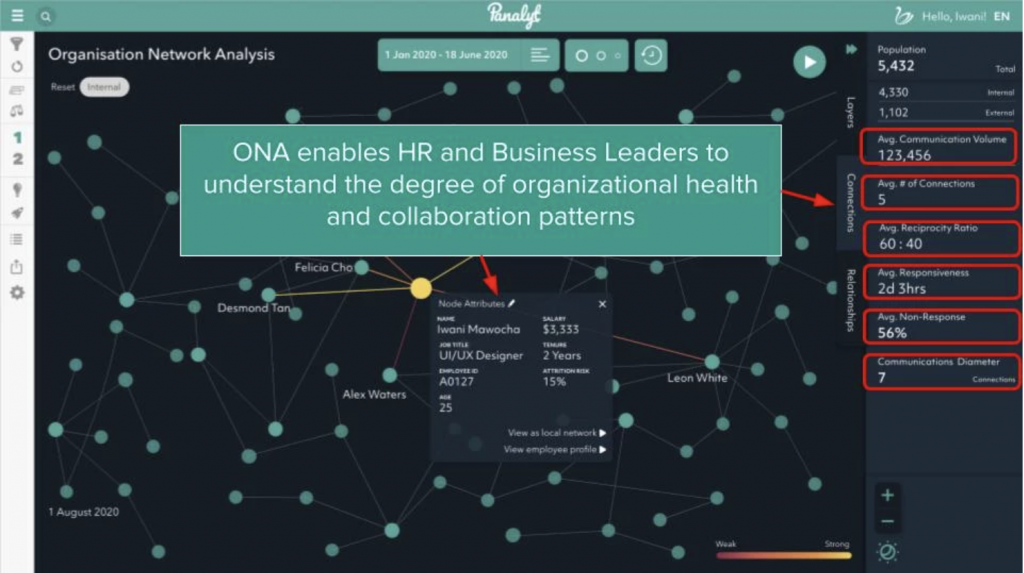
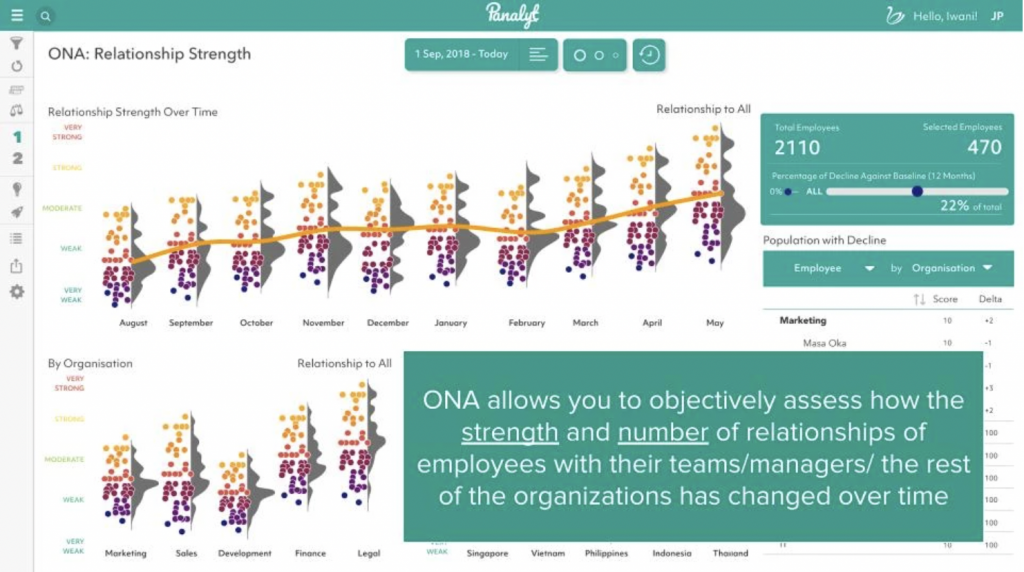
By analyzing changes in the relationship score and the number of relationships for employees, organizations can have an extremely clear indicator of people disengaging from the organization* – when the number of relationships for an employee drops significantly while the average relationship strength stays the same or even higher within the smaller network ( mostly friends)
* this could also be due to a change in role or an employee going on leave
For example, if someone goes from having 20-30 solid relationships to three or four in a short period, it’s a clear sign that they’re either being excluded from the culture or pulling away from it.
A real-life example from Uber from back when Panalyt CEO Daniel West used to head HR International for the firm:
Uber’s People Analytics team found that the number of meaningful connections was found to shrink rapidly in a sustained manner over 3–4 months before the employees left. While the average relationship strength with the remaining close connections ( mostly friends within the company) went up, the number of people they had a high relationship strength with within the company decreased drastically.
Exit interviews revealed that these people noticed that they were either pulling back or being pushed out of the company only 3–4 weeks before they left, allowing Uber to have a 3 month lead time to plan necessary interventions for high attrition risk talent.
More real-life examples of Relational Analytics: https://panalyt.com/post/relational-analytics-case-studies/
Identifying and speaking with employees who are disengaging or getting isolated from the organization can help HR leaders and managers identify where to intervene in order to reduce attrition/disengagement. In addition, people who had strong relationships with employees who left the firm can also share further qualitative insights on the possible reasons behind someone leaving the firm.
While Relational Analytics can be an incredibly powerful method to identify which employees are disengaged or at high risk of leaving your organization, it doesn’t give you any context on why that’s happening.
At Panalyt, our proprietary Machine-Learning driven Attrition/Engagement Risk Prediction model analyzes various data points across both the core HR and ONA data to identify the likelihood of an employee* leaving the firm along with the possible reasons why.
* Analysis can also be limited to cohorts of employees rather than at the individual level if desired
Optimizing Onboarding To Enable New Hires for Success
A consistent pain point that we’ve come across through the pandemic as organizations have embraced remote and hybrid working arrangements is:
How can we ensure that new hires are effectively integrating into the organization and becoming culturally connected?
According to Rob Cross ( Organizational Network Analyis pioneer), “In a strong culture, it can take three or five years for a new hire to become truly connected in the way that your high performers are, but with ONA, you can cut that time significantly down to 9 to 12 months – and especially in the case of remote and hybrid onboarding, ensure your new hires are able to effectively build relationships with their managers, teams and the wider organization.”
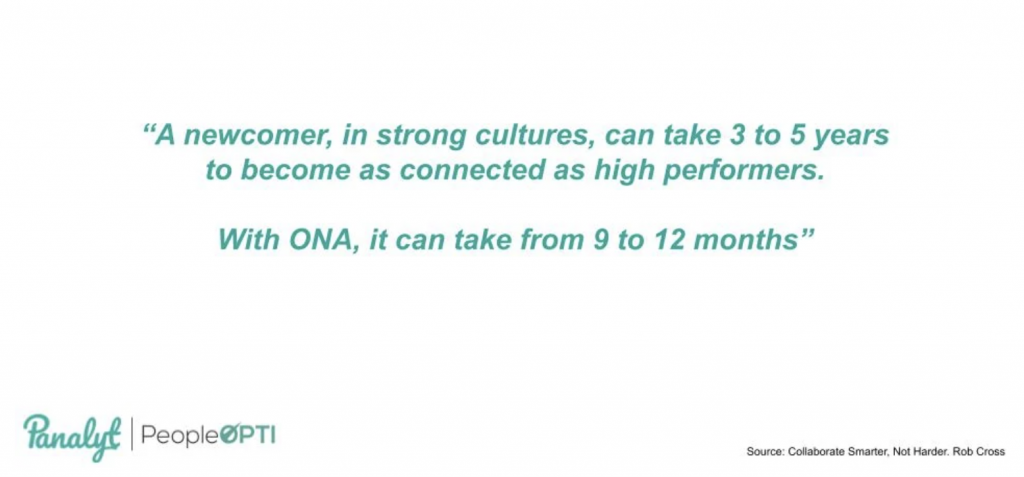
The traditional approach to onboarding is that when a new employee joins the company, you decide where that individual will be assigned in your organizational chart. We place the newcomer in a hierarchical network, and expecting the group to step in and help that newcomer.
Informal mentor/ buddy programs where employees nominate themselves also usually don’t consider internal network of the mentor/ buddy, which can be an integral factor into how a new hire integrates into an organization, especially for younger hires.
However, organizations fail to consider that the group may be massively overworked, or that they may have an impending deadline, or their manager may have recently changed; we expect the hierarchical group to bond with the new hire even though they may have no other attributes or demographic points in common, and then the person leaves six months later because they weren’t properly brought into the broader culture or the organization’s internal social network.
Relational Analytics is a powerful tool for determining if you’re getting your onboarding process right or wrong, and assisting HR business partners and managers in making the necessary interventions to help new hires integrate into the organization or into their new roles.
HR practitioners can leverage Relational Analytics / ONA insights to plan where and how to build a network for a new hire, and tailor the onboarding process and organizational design to promote inclusion, productivity, to improve the engagement process, and efficiency.
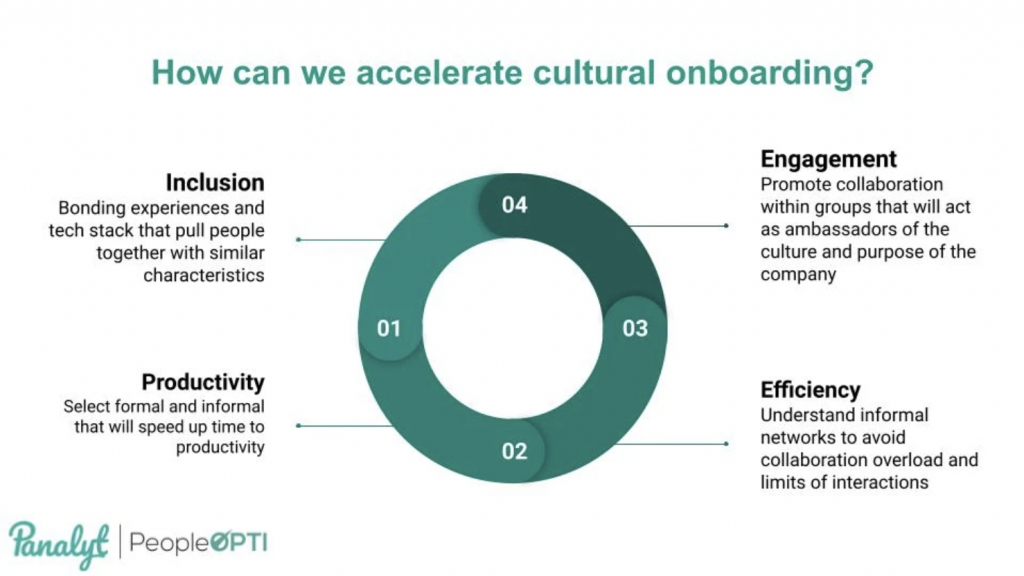
Analyzing historical network patterns of new hires in their first 6-12 months, can help understand how current high performers built their networks while integrating into the organization; allowing you to help new hires / high-potential employees in a certain role to build an internal network that can set them up for success by nurturing and coaching talent to become high performers, and greatly improve their chances of being high performers and moving upwards ( promotions, or even internal moves) within the organization.
Morever, If you recruit a high performer, but then place him or her in a network that isn’t high performing or poorly built, that high performer can quickly become a low performer, and you can easily get your onboarding process and design completely wrong.
Using insights from Relational Analytics to help employees build more effective internal networks can be an invaluable addition as part of a total Diversity & Inclusion strategy, helping address issues like exclusion, or a lack of diversity in high-performing groups or senior roles.
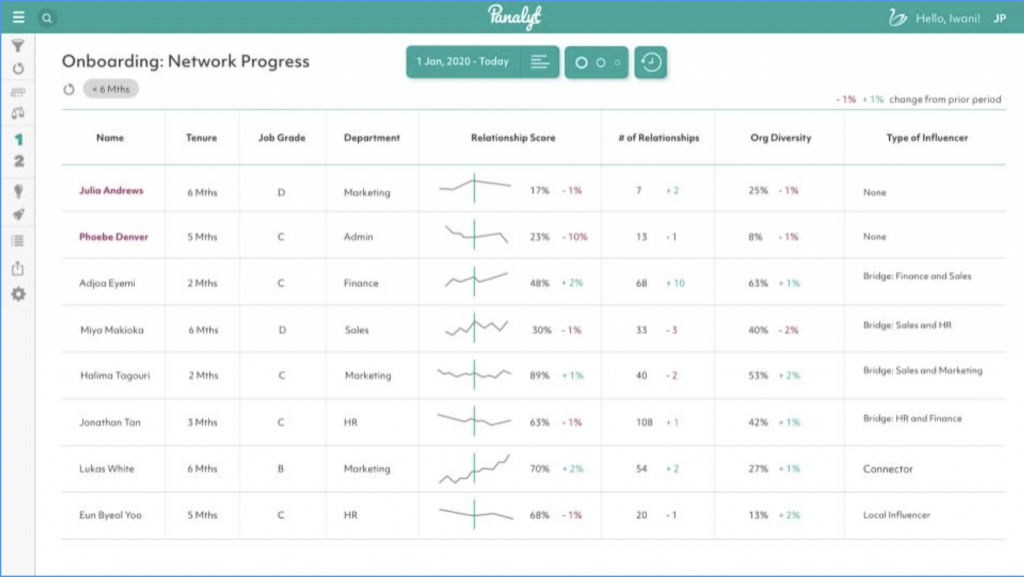
Measuring Inclusion with Relational Analytics: https://panalyt.com/post/measuring-inclusion-with-relational-analytics/
Accelerating Advancement of Diverse Talent with People Analytics and Relational Analytics: https://panalyt.com/post/peopleanalyticsdiversityequityinclusionbelonging/
How To Succeed Quickly in a New Role, by Rob Cross, Greg Pryor and David Sylvester for HBR:https://hbr.org/2021/11/how-to-succeed-quickly-in-a-new-role
Improving Organizational Agility
Organizational design usually goes hand in hand with business strategy, where teams are structured / restructured in order to achieve the desired business goals and objectives.
Firms spend a lot of time and money on organizational design projects to implement more agile working structures, however they don’t have an objective means to understand whether teams are collaborating as desired in real-time, and course correct without waiting for the results and feedback a year later to see if they’ve successfully transitioned from a hierarchical to a more agile or collaborative structure.
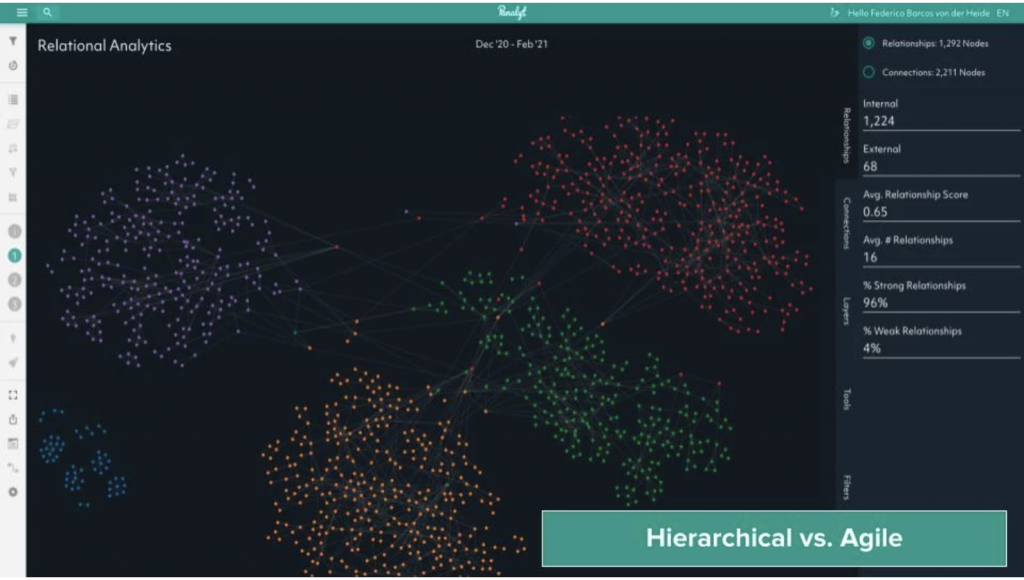
Whether it is a post-merger integration initiative or an agile transformation, Relational Analytics allows you to see if your actions or initiatives are having an impact on improving collaboration within the organization, i.e. whether your desired formal organizational changes is translating into actual changes in how employees communicate and collaborate with each other.
When trying to understand how your organization is evolving from a more hierarchical to a more agile structure, Relational Analytics allows you to determine if teams are collaborating as expected* or if you’re seeing different patterns of collaboration between teams as expected, and understand the collaborative structure and types of relationships between different teams in your organization.
Layering in Performance data allows you to understand the difference in how high-performing teams/individuals collaborate as opposed to low-performing teams/individuals, and identify areas of intervention and coaching to help talent build their internal networks more effectively in order to be set up for success in their role.
The relationship strength between different teams can also be seen as a measure of trust**, i.e. how much are teams willing to share information and knowledge with each other, and understanding which relationships need interventions can help reduce the number of silos & cliques within your organization.
*, ** This does not apply to cases where certain teams are siloed by design.
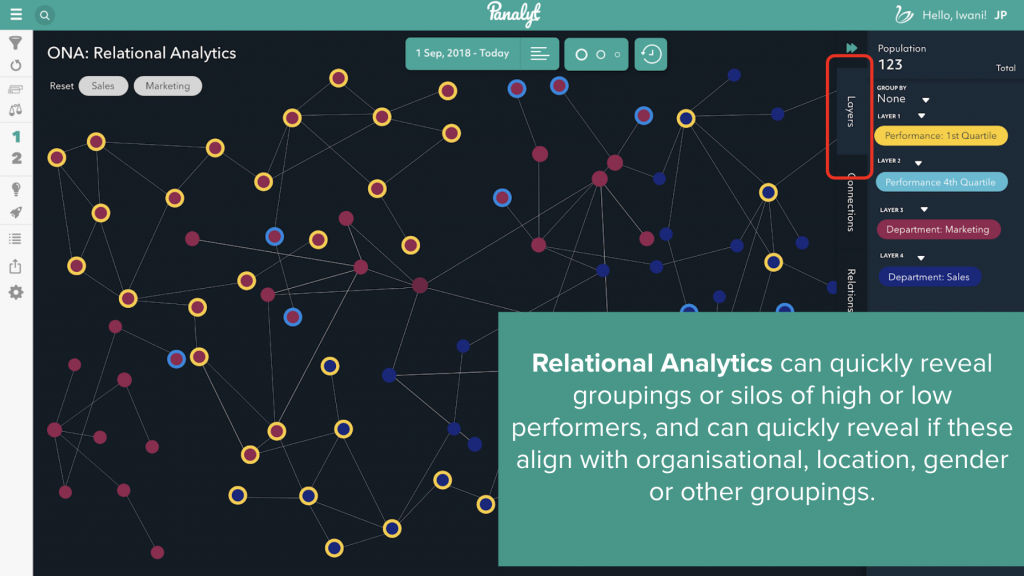
Relational Analytics can also help you understand how effectively is management connected to the front lines of the organization and assess if decision-makers are able to get context from the field before spending the collective time and effort on a large change initiative.
Driving Business Performance with Relational Analytics: https://panalyt.com/post/driving-business-performance-with-relational-analytics/
Breaking Organizational Silos and Identifying Key Individuals to Promote Collaboration and Change Initatives
It’s a known fact that silos can be highly destructive for companies. Silos and cliques perenially remain hot topics in organizational design.
It is a major risk for the organization when teams are isolated from each other within the company, with only one or two people connecting the isolated teams with the rest of the organization, usually referred to as bridges in network science – especially considering the communication breakdown if they leave, and at scale, this is very damaging for the organization, both from an engagement as well as a performance standpoint.
Relational Analytics can highlight how teams are collaborating compared to the desired organizational structure, as well as highlight risks associated with the proposed design that are not obvious when viewing organizational charts.
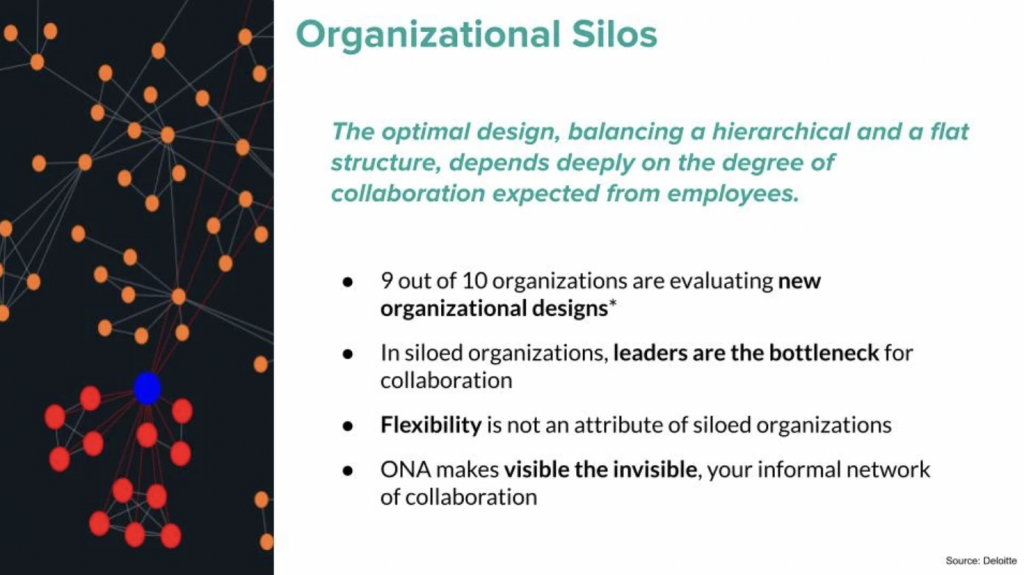
Only considering organization charts in isolation while designing organizations only propagates silos, as employees are continually onboarded within their siloed functions and then expected to cross-collaborate and communicate freely within the organization.
Relational Analytics enables you to determine who are the bridges between different teams in your organization, recognize and support them by helping other individuals build connecting relationships between siloed units, and strategically leverage these network bridges to stimulate cross-collaboration, while also minimizing the possibility of the leader becoming a bottleneck for collaboration or information flow.
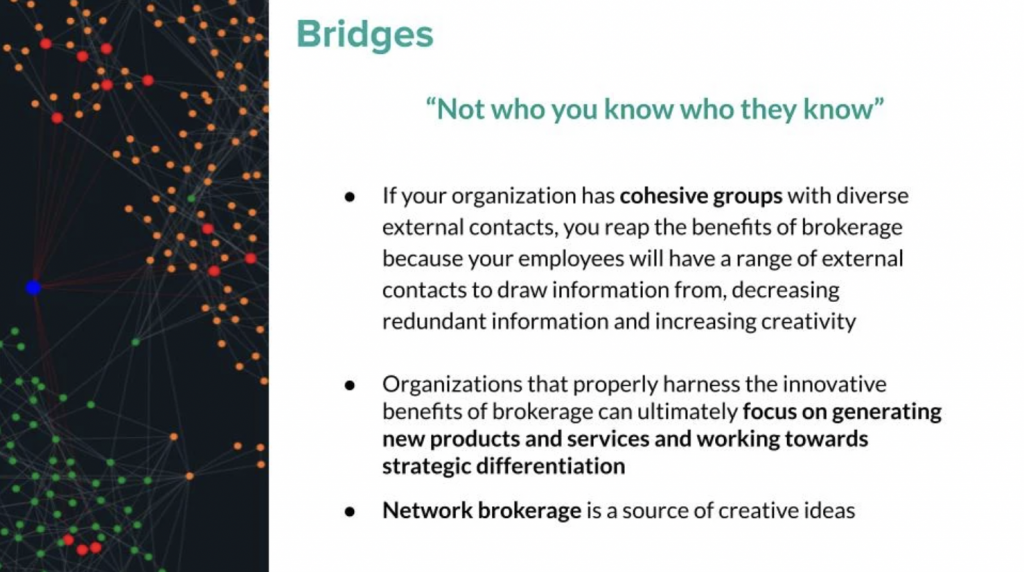
An organization’s future business outcomes, i.e. whether projects/initiatives are successful or not, is largely dependent on how knowledge is shared within the organization, which makes it extremely important to identify and understand how and whom your employees are connected to.
Bridges or knowledge brokers in your organization can be seen as people who connect different regions, different teams, or even different job grades, and these bridges are critical for an efficient information and communication flow to promote knowledge sharing and innovation within a firm.
However, these bridges or informal leaders are also at a high risk of burnout as they can be exhausted as a result of coordinating the information flow. HR and managers must consider the time and effort spent by bridges to facilitate collaboration in their roles to appropriately balance their workload to reduce burnout, as bridges tend to be people with the longest tenure in the firm who have the best understanding of how the organization functions and whom to best reach out to for information/help with a cross-functional issue.
Organizations must pay special attention to the bridges/knowledge broker and have plans in place to transmit the knowledge and relationships of the bridge to another employee or a wider group because if a network bridge leaves or retires, there will otherwise be a significant loss of both knowledge and social capital which will cause damage to the organization.
Relational Analytics can assist organizations in proactively identifying and resolving such issues before they occur.
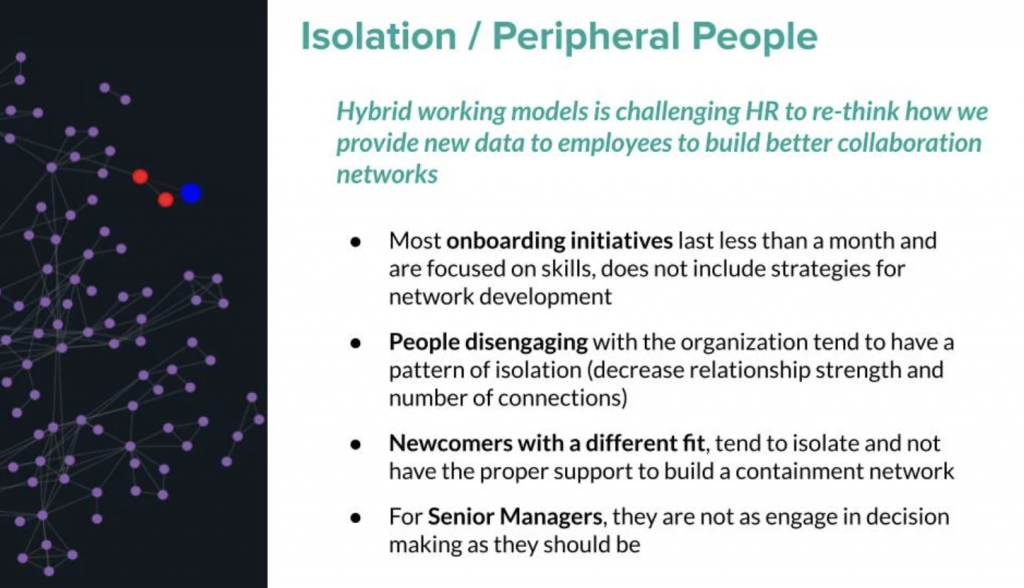
Relational Analytics can be extremely useful for HR while designing engagement initiatives for new hires. HR can assist new hires strategically build relationships within the organization to help them integrate and culturally fit into the organization.
In our experience, we’ve found that making the insights from Relational Analytics available to managers and individual employees, requires HR to first lead a communication and education initiative about why the analysis is being done and how ONA insights can help drive improved employee outcomes, and prepare a toolkit for how to help employees understand their own network.
With that in mind, an individual employee’s ability to see their breadth of relationships can be a real eye-opener, revealing that they either don’t have the relationships they thought they had, or that they believe they aren’t particularly networked but have in fact been developing good relationships
With that in mind, an individual employee’s ability to see their breadth of relationships can be a real eye-opener with the data supporting or correcting people’s claims, revealing that they either don’t have the relationships they thought they did in their heads or that they believe they aren’t particularly networked but have actually been developing good relationships.
In addition, managers too can now understand the strength of their relationships with their direct and indirect reports, and accordingly intervene to build better relationships with isolated team members.
Relational Analytics empowers HR business partners and line managers to proactively identify employees who are isolated or showing patterns of becoming isolated , and accordingly intervene as needed.
For An Agile Transformation, Choose The Right People, Rob Cross, Heidi K. Gardner and Alia Crocker: https://hbr.org/2021/03/for-an-agile-transformation-choose-the-right-people
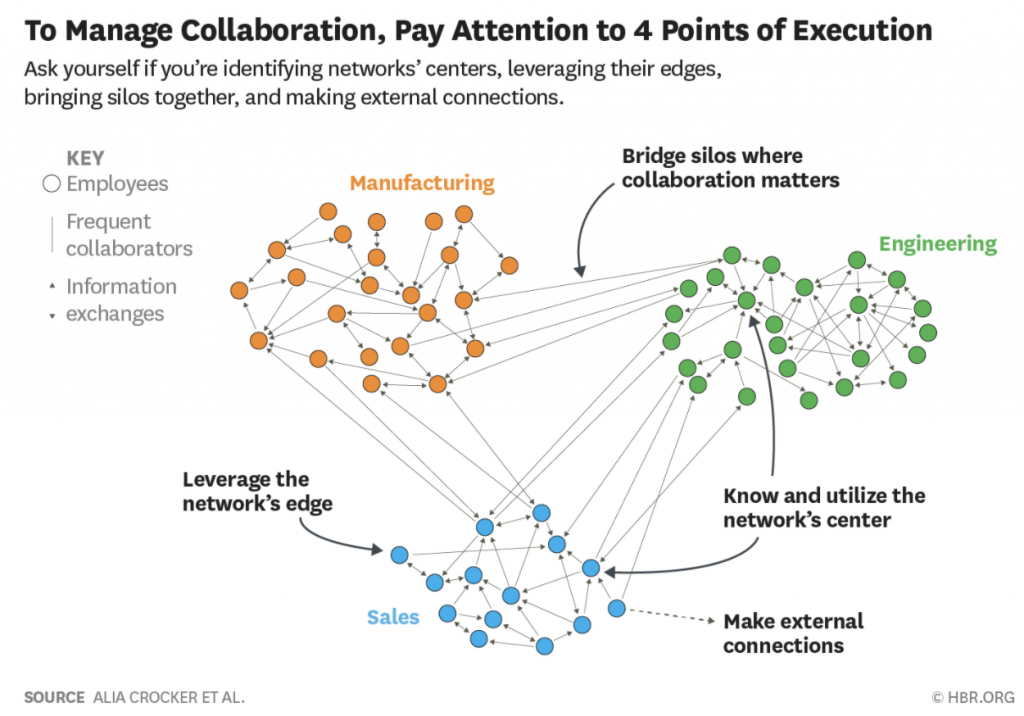
Improving Customer Relationships and Sales Effectiveness
Accelerate Remote Sales Productivity with Relational Analytics: https://panalyt.com/post/accelerate-remote-sales-productivity-with-relational-analytics/
Relational Analytics can also help understand external relationships along with internal relationships, such as how customer-facing teams such as sales and customer success build relationships external prospect and client relationships, and whether they are connected to the right people from other functions in the organization to be effective in their roles, whether it’s sales working with marketing and finance to progress a deal or customer success working with the development team to resolve a customer issue.
Relational Analytics can help organizations have an objective pulse on important, frequently asked questions like:
- How are new sales executives building client relationships and how can sales managers coach them to build better relationships?
- What is the strength of the sales team’s relationships with decision-makers at prospect and client organizations?
- Do sales reps have the right internal connections to move a deal forward?
- Where do we carry risk in our customer facing relationships? i.e. sales reps with high attrition risk translating into lost prospect/ client relationships
While we’ve previously discussed several metrics used to calculate the relationship score between individuals, there is one particular metric which is highly correlated to a successful sale: Client Responsiveness, i.e. how quickly clients respond to the sales team, is an extremely strong indicator for the likelihood of a deal closing.
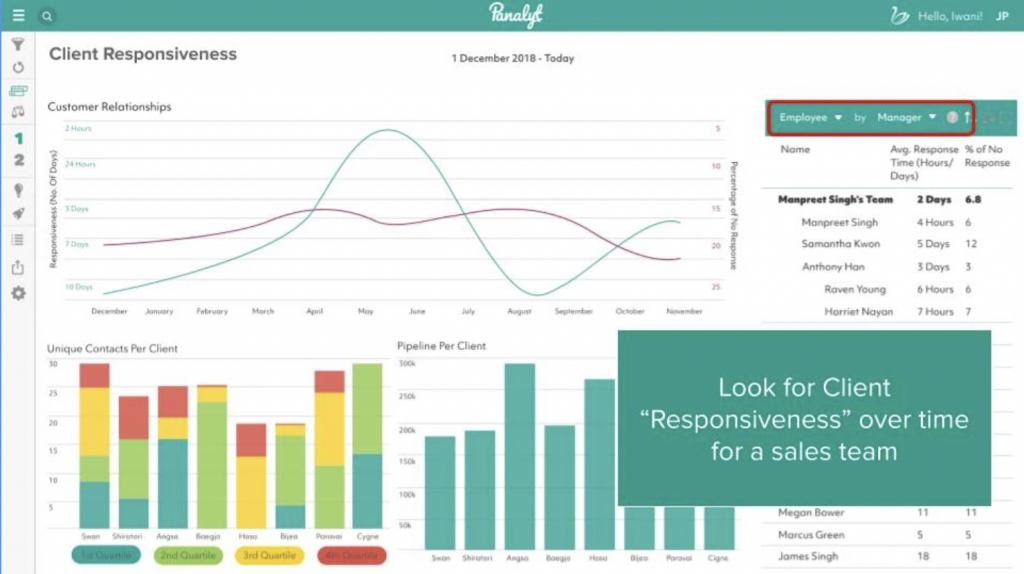
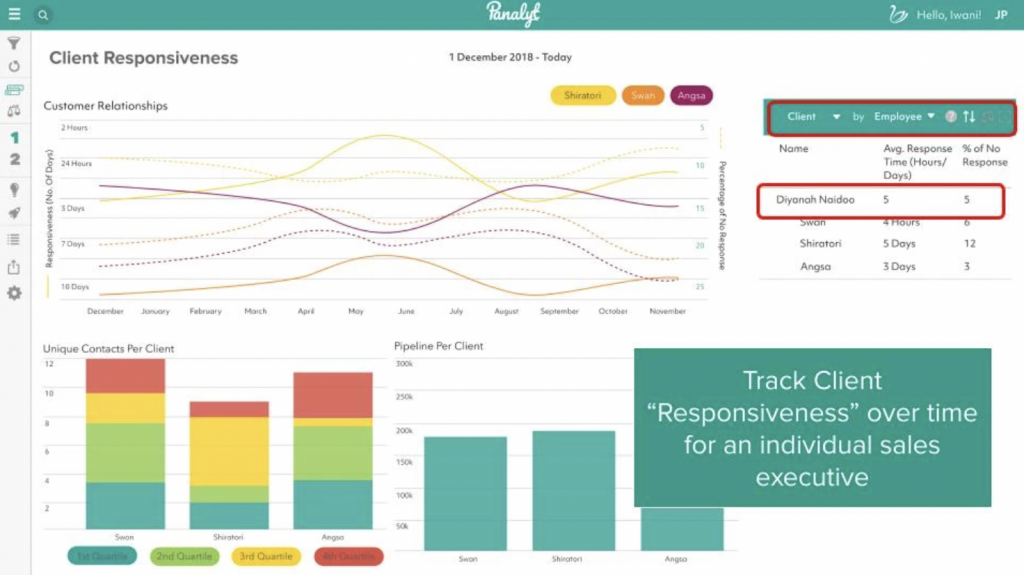
Identifying the customer relationships of sales reps can be an invaluable aid when onboarding new / lateral hires, or promoted reps, as they can work on building up their relationships with the accounts the incumbent was previously connected to, and track how responsive the client contact is to them as compared to the historical responsiveness, to assess whether they’re picking up the relationship sufficiently.
Relational Analytics can help sales managers and HR business partners for sales teams track the strength of customer relationships by client/ prospect company or by salesperson or by specific contacts at the client, and understand how frequently and how when they were last contacted.
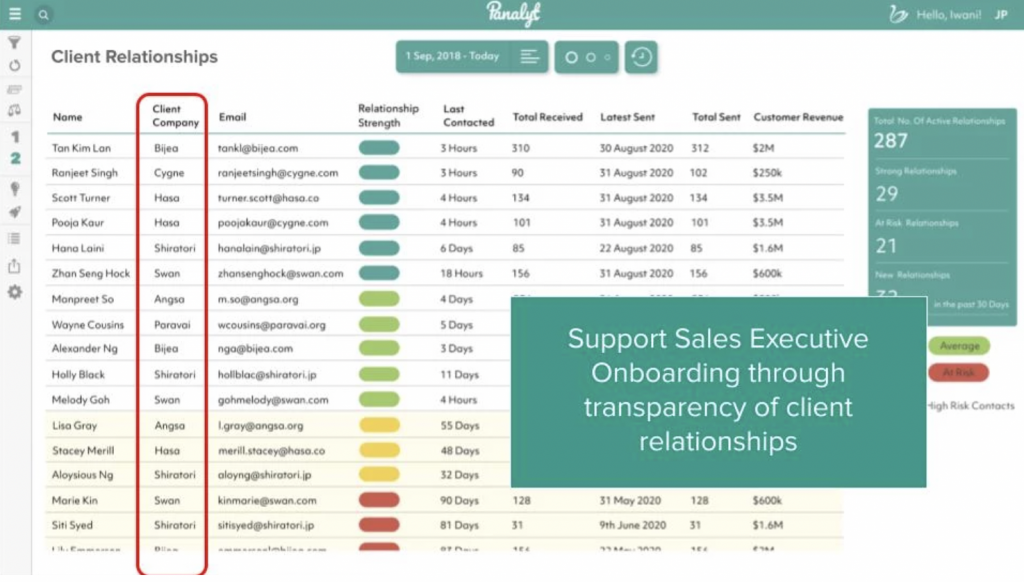
In addition, Relational Analytics can also provide a means to visualize the strength of a sales teams / individual sales rep with key high-value clients, enabling sales leaders to identify clients with the weakest relationship to the firm, and motivate their sales team to improve those relationships.
This particular visual is useful for sales onboarding, to look at the gravity of relationships with key high-value clients so that the sales individual or team is the node on the left-hand side, as the center of gravity, and then we can see at a glance where the strongest relationships are per client where the weakest relationships are. Sales leaders would want to concentrate on the weakest relationships to motivate their sales force to improve them.
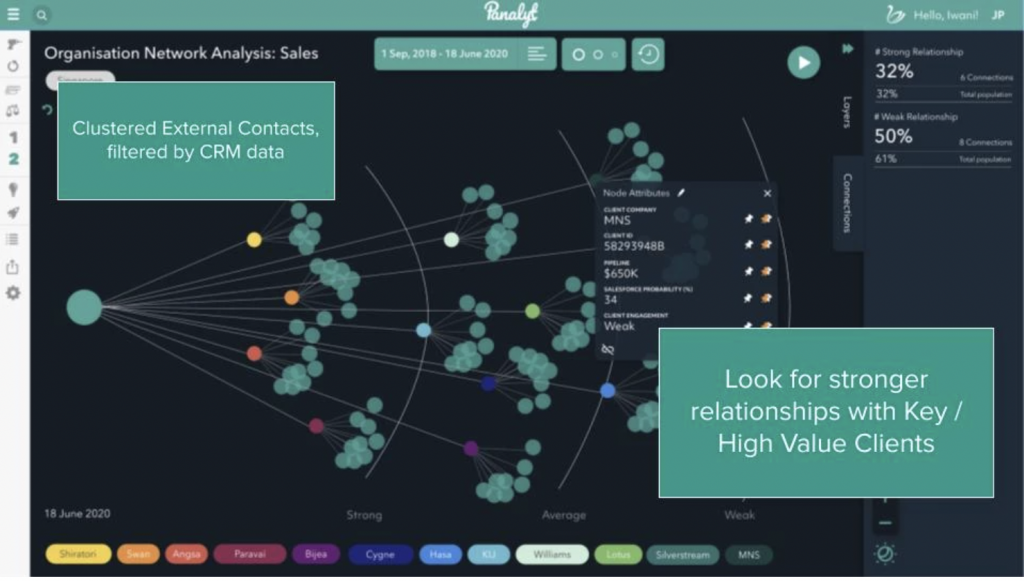
About Panalyt
Panalyt bridges the People-Data Gap, enabling real-time, uniform access to relevant people data, reports, and insights for CxOs, HR and business managers.
People data, including employee interactions and connections is combined with business data empowering businesses to leapfrog to data-driven decision making, eliminating bias and improving engagement, sales effectiveness, productivity and, as a result, business performance.
Interested in a further discussion on how People Analytics and Relational Analytics can help you drive improved employee and business outcomes? Book a 30-minute discovery call with our Panalyt co-founders to learn more!







